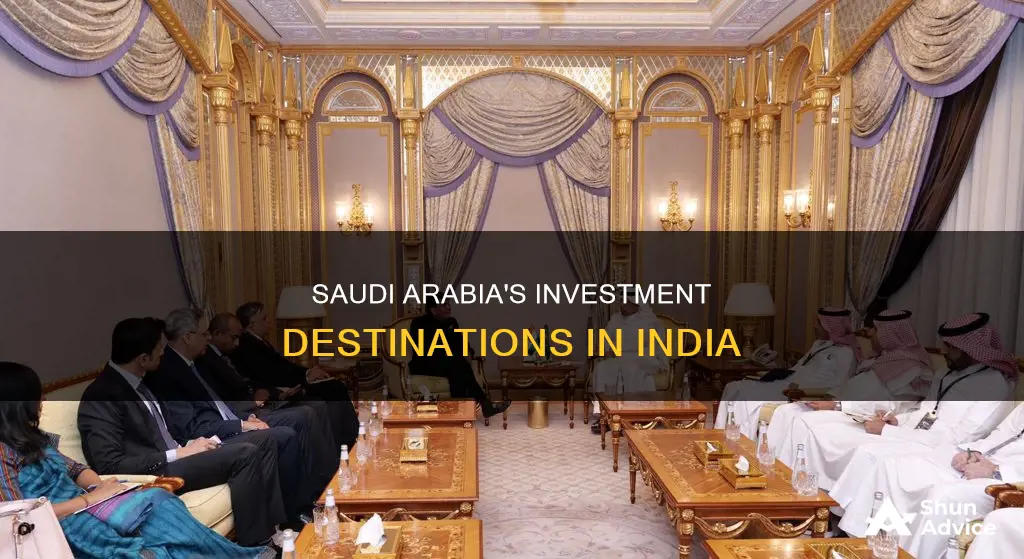
Saudi Arabia and India have a strong relationship, especially when it comes to commercial interests. In 2019, Saudi Arabia's ambassador to India, Saud bin Mohammed Al Sati, said the kingdom was looking to invest \$100 billion in India across energy, refining, petrochemicals, infrastructure, agriculture, minerals, and mining. This investment will help India meet its infrastructure goals and will also aid Saudi Arabia in its aim to diversify its economy and reduce its dependence on income from oil.
| Characteristics | Values |
|---|---|
| Amount | $100 billion |
| Areas | Energy, refining, petrochemicals, infrastructure, agriculture, minerals, mining |
| Reasoning | India's growth potential, India's value chain from oil supply, marketing, refining to petrochemicals and lubricants, India's invitation to Saudi Arabia to invest in its strategic petroleum reserve |
| Investor | Aramco |
What You'll Learn

Energy, refining, petrochemicals, infrastructure, agriculture, minerals and mining
Saudi Arabia is the fourth-largest trade partner of India, and the latter sources around 17% of its crude oil requirement from the Kingdom. Saudi Arabia is also India's fifth-largest trading partner.
Energy, Refining, and Petrochemicals
Saudi Arabia has been investing heavily in India's energy sector. Saudi Aramco, the Saudi state-owned oil company, has formed a joint venture with Indian state-run oil companies, Indian Oil Corporation (IOC) and Bharat. Saudi Aramco has also invested over $100 million in its technology and innovation centre in Bengaluru, one of the largest Saudi investments in India.
The company's president and CEO, Amin H. Nasser, has stated that Saudi Aramco will invest more than $100 billion in petrochemicals over the next decade, aiming to bring its downstream business to the same level of prominence as its upstream operations. Saudi Aramco is also in negotiations for a major share in Riyadh-based diversified chemicals leader SABIC, with the aim of creating one of the world's strongest integrated energy and chemicals companies.
Infrastructure
Saudi Arabia's Sovereign Wealth Fund, PIF, has acquired a 2.32% stake in Jio, an Indian digital company, for 11,367 crore rupees. This is PIF's largest investment in India to date.
Agriculture
Saudi Arabia's Ministry of Investment has signed an agreement worth $1 billion with an Indian company, UPL Limited, to manufacture specialised agricultural chemicals within the Kingdom.
Minerals and Mining
The Saudi Arabian Mining Company (Ma'aden) has signed two memorandums of understanding (MoUs) worth $2 billion with Indian companies, IPL Co. and KRIBHCO, for the transfer of 5 million tonnes of phosphate fertilizers from Saudi Arabia to India.
Savings and Investments: A Comprehensive Guide
You may want to see also

Aramco's proposed partnership with Reliance Industries
Saudi Aramco, Saudi Arabia's biggest oil company, has proposed a partnership with Reliance Industries Ltd, a move that reflects the strategic nature of the growing energy ties between the two countries.
In August 2019, the two companies signed a non-binding letter of intent for Saudi Aramco to acquire a 20% stake in Reliance's oil-to-chemicals (O2C) business, in a deal worth $15 billion. The deal was expected to benefit RIL's O2C business in terms of higher feedstock security and a tilt towards higher crude-to-petrochemical conversion. However, in November 2021, the two companies decided to re-evaluate the proposed investment due to evolving business priorities and a changing energy landscape.
Reliance, helmed by billionaire Mukesh Ambani, has shifted its focus towards renewable energy investments and plans to develop one of the largest integrated renewable energy manufacturing facilities in the world. This includes a complex of solar photovoltaic module, battery, green hydrogen, and fuel cell factories. The company has also set a target to be carbon net-zero by 2030 or 2035 and has acquired a Norwegian solar panel maker and an Indian builder of renewable projects as part of its transition to alternative energy.
Despite the re-evaluation of the initial deal, Reliance has reiterated its commitment to Aramco, stating that it will remain Aramco's preferred partner in India and will continue to collaborate on future investments. The two companies will explore broader areas of cooperation and aim to create a win-win partnership.
The proposed partnership between Aramco and Reliance Industries is a significant development in the energy sector, highlighting the strategic nature of the growing energy ties between Saudi Arabia and India.
Morgan Stanley: Leading the Way in Investment Management
You may want to see also

India's strategic petroleum reserve
The construction of these strategic reserves was proposed by the Atal Bihari Vajpayee administration in 1998, following the Gulf War in 1990, which caused a sharp rise in oil prices and a crisis in India's economy. The first phase of development included the three storage facilities mentioned above, with a total investment of $600 million.
In recent years, there have been plans to expand India's strategic petroleum reserves further. In 2017, the Indian finance minister, Arun Jaitley, announced that two more caverns would be set up in Chandikhole, Odisha, and Bikaner in Rajasthan as part of the second phase. In 2018, the Narendra Modi administration approved the construction of the new storage facility in Chandikhole and the expansion of the Padur facility, increasing India's strategic reserve capacity to 11.83 million tonnes.
Viewing Your Acorns Investment Portfolio: A Simple Guide
You may want to see also

Saudi Arabia's Vision 2030
Saudi Arabia has been investing in India's energy sector, with a focus on oil and gas projects. In 2019, Saudi Arabia's Aramco proposed a partnership with Reliance Industries, reflecting the strategic nature of the growing energy ties between the two countries. Saudi Arabia is a key pillar of India's energy security, supplying 17% or more of its crude oil and 32% of its LPG requirements.
To create a vibrant society, Saudi Arabia will focus on its people and the Islamic faith. This includes increasing the number of Umrah visitors, establishing the world's largest Islamic museum, and promoting cultural and entertainment opportunities. The Kingdom also aims to encourage healthy lifestyles and develop its cities, with a goal to have three cities recognized in the top 100-ranked cities globally.
For a thriving economy, Saudi Arabia aims to diversify and create dynamic job opportunities. This includes a commitment to education, entrepreneurship, and innovation, with a focus on unlocking underdeveloped industries such as manufacturing, renewable energy, and tourism. The Kingdom also plans to modernize the curriculum and standards of its educational institutions.
To be an ambitious nation, Saudi Arabia will emphasize accountability, transparency, and effectiveness in its governing strategy. This includes establishing zero tolerance for corruption, boosting transparency by expanding online services, and improving governance standards. The Kingdom also aims to train more than 500,000 government employees in best practices through the King Salman Program for Human Capital Development.
Vision 2030 aims to transform Saudi Arabia's economy and society, reduce its dependence on oil, and create a prosperous future for its citizens. The plan outlines specific objectives to be achieved by 2030, with a focus on economic diversification, social progress, and effective governance.
Home Purchase: Investment or Saving Strategy?
You may want to see also

India's economic liberalisation
The liberalisation process involved a series of policy changes aimed at making India's economy more market-oriented and consumption-driven. One of the key measures was the abolition of the Licence Raj, a system of licenses and regulations that had hampered private enterprise since 1947. Up to 80 government agencies had to be satisfied before a business could produce something, creating a maze of bureaucracy that hindered even the most committed entrepreneurs. By removing these restrictions, the Indian government made it easier for businesses to operate and enter new industries.
Another important aspect of economic liberalisation was the encouragement of foreign investment. The government eliminated restrictions on foreign investment, allowing foreign companies to bring modern technology and industrial development to the country. This move increased foreign investment and contributed to the growth of various sectors, including telecommunications, software, pharmaceuticals, and biotechnology. The liberalisation process also included the reduction of import tariffs, the privatisation of public sector enterprises, and the cutting back of state spending.
The impact of economic liberalisation on India was significant. It led to an increase in foreign investment, with foreign investment in India rising from $132 million in 1991-92 to $5.3 billion in 1995-96. It also resulted in the creation of millions of new jobs and made India globally competitive in several sectors. Additionally, poverty rates decreased from 36% in 1993-94 to 26.1% in 1999-2000.
However, the benefits of economic liberalisation were not evenly distributed, with urban areas benefiting more than rural areas. Critics of economic liberalisation have also pointed to negative consequences, including widening income inequality, social disparities, and negative environmental impacts. Despite these concerns, India's economic liberalisation played a crucial role in bolstering trade with Saudi Arabia. The policy changes made India a more attractive destination for Saudi investments, particularly in sectors such as energy, refining, petrochemicals, infrastructure, and agriculture.
Aramco IPO: Guide for Indian Investors
You may want to see also
Frequently asked questions
Trade and cultural links between ancient India and Arabia date back to the third millennium BC. By 1000 AD, trade relations between southern India and Arabia were flourishing and became the backbone of the Arabian economy. Formal diplomatic relations between contemporary India and Saudi Arabia were established soon after India gained independence in 1947.
Saudi Arabia is one of the largest suppliers of oil to India, who is one of the top seven trading partners and the fifth biggest investor in Saudi Arabia. The two countries share similar views on combating terrorism.
Saudi Arabia is looking to invest in India in the areas of energy, refining, petrochemicals, infrastructure, agriculture, minerals and mining.
Saudi Arabia is looking to invest $100 billion in India.
Saudi Arabia's investment in India will help India meet its target to invest INR 100 trillion on infrastructure by 2024-25. It will also help Saudi Arabia diversify its economy and reduce its dependence on income from oil.







